DMM 5 in 1 (VA19)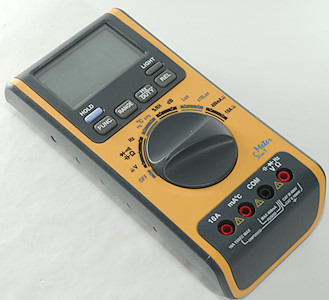
This is a fairly cheap DMM with all common function and some environment measurements also.
The one I got do not have a brand name on it.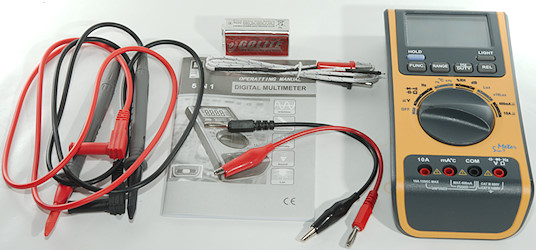
It included the DMM, a pair of probes, a pair of probes with aligator clips, a thermocoupler and a manual.


The ony rating on the probe is 10A. The isolated tip is nice.

The termocoupler looks fairly standard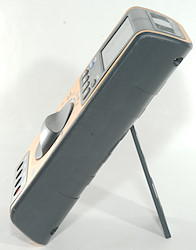 ]
]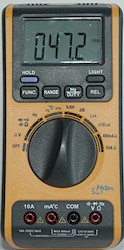
When using the tilting bale the meter is not stable enough to turn the switch and push the buttons.
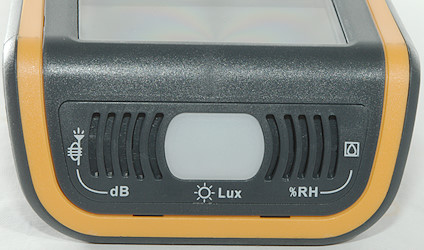
On the top of the meter is the microphone, photo sensor and humidity sensor. Due to the construction of the meter it is not possible to alight the light sensor directly vertical or horizontal except on eyesight.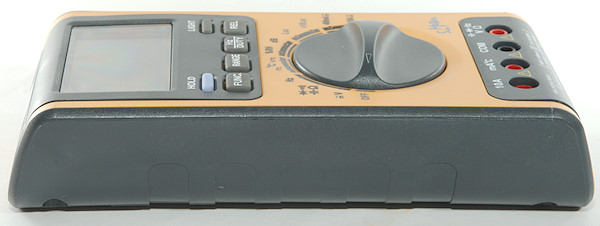

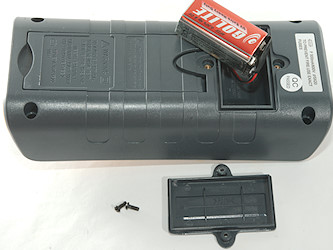
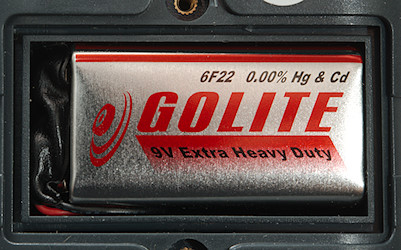
Space is very tight in the battery compartment, this is not very nice.
Display
The above picture shows all voltmeter the segments on the display, segments for enviroment is not shown.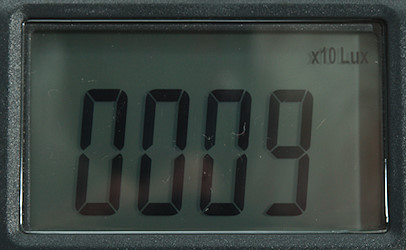
Here is one of the symbols missing above (x10 Lux).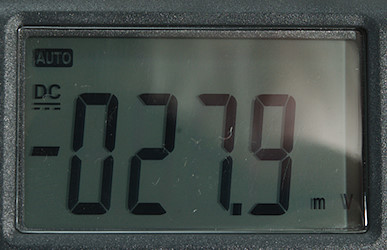
Typical display during usage, it will show the number and what measurement is selected.
Functions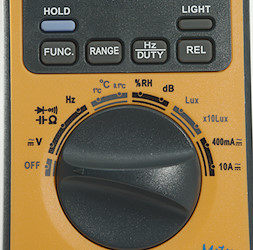
Buttons:
- HOLD: Freezes the display, press again to unfreeze.
- LIGHT: Turn on the background light, cannot be turned off manually.
- FUNC.: Select between AC/DC and ohm/continuity/diode/capacitance
- RANGE: Manual range in V, ohm and mA
- Hz/DUTY: Select Hz and duty cycle in volt and current ranges. Select duty cycle in frequency range.
- REL: Zeros display and shows relative values in all ranges.
Rotary switch:
- Off: Meter is turned off
- V: Used for mVDC, VDC and VAC, use FUNC. to select between AC/DC
- Ohm: Used for ohm/continuity/diode/capacitance, use FUNC. to select with.
- Hz: Frequency, use HZ/DUTY button to select between frequency and duty cycle.
- 1°C: Temperature
- 0.1°C: Temperature
- %RH: Humidity
- dB: Sound level.
- Lux: Light
- x10Lux: Light, there is no comma or K on display, but a X10 LUX annotation in the display.
- 400mA: Current AC and DC. Starts in DC, press FUNC for AC. Use HZ/DUTY to show frequency.
- 10A: Current AC and DC. Starts in DC, press FUNC for AC. Use HZ/DUTY to show frequency.
Input
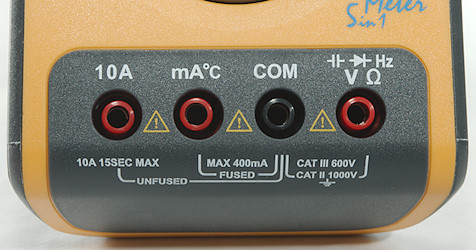
- 10A: High current, only rated for 10A in 15 seconds
- mA: The lower current ranges and the thermocoupler input.
- COM: The common terminal for all ranges.
- xxx: All other ranges.
The terminals are a bit loose in the mounting due to the way they are made. Standard probes will fit.
Measurements
Spaceing between input terminals is not standard!
- Volt and frequency
- Frequency input needs 180mV rms before it will count.
- At 1Vrms input frequency range is from 2Hz to 8MHz
- AC volt can measure up to about 1kHz
- Frequency counter and duty cycle do not require zero crossing in Hz range, but do in V range.
- Input impedance is 10 to 11Mohm in DC and AC
- Rated overload protection on mV range is 250V DC/AC
- Rated overload protection on V range is 600V AC/DC
- Rated overload protection on frequency range is 250V AC/DC
- Frequency input needs 180mV rms before it will count.
- Current
- On the 400mA and 10A range there is an audible alarm when going above range.
- 10A range is unfused!
- 400mA and temperature range is protection is 500mA/600V 5×20mm fuse.
- On the 400mA and 10A range there is an audible alarm when going above range.
- Ohm, Continuity, diode and capacity
- Ohm needs about 4s to measure 100ohm
- Ohm is 0.42V open and 0.21mA shorted
- Continuity is slow (About 120ms).
- Continuity beeps fully when resistance is below 28ohm and stops making noise at about 60ohm.
- Continuity is 0.44V open and 0.21mA shorted
- Diode range uses 1.5V, max. display is 1V at 0.2mA, max. current is 0.56mA shorted
- 100uF takes about 20 seconds to measure.
- The lowest capacity range is not very precise
- Rated overload protection is 250V DC/AC
- Ohm needs about 4s to measure 100ohm
- Miscellaneous
- Sound meter do not follow a A or C curve and will show too high at lower frequencies (+10dB at 250Hz from A)
- Light meter is fairly precise with incandescent, but is filtered very badly.
- Due to the angled top it is difficult to hold the light sensor perpendicular to the light source.
- Thermocoupler input is not very precise at higher and very low temperatures.
- Current consumption of meter is 2.0mA (40mA with backlight)
- Current consumption of meter in enviroment is 7mA (45mA with backlight)
- Display fades at 1.9V, battery symbol show at 6.8V (Second symbol at 2.3V).
- Voltage reading is stable down to about 2.4V battery voltage
- Temperature reading are stable down to about 4.7V battery voltage
- Backlight works down to about 2.6V where it is fairly dim.
- The meter usual need a couple of display update to reach the final value.
- Viewing angle is good
- Display updates around 3 times/sec
- Standard probes fits, but distance between input terminals is non-standard.
- Backlight fades in about about 10-12 seconds.
- Will automatic turn power off in about 15 minutes.
- Weight is 290g without accessories, but with battery.
- Size is 180 × 84 × 48mm.
- Sound meter do not follow a A or C curve and will show too high at lower frequencies (+10dB at 250Hz from A)
- Probes
- Probe resistanse 36mOhm for one.
- Probe wire is soft and 82cm long.
- Aligator clip resistanse 11mOhm for one.
- Aligator clip wire is soft and 5cm long.
- Probe resistanse 36mOhm for one.

A look at the capacity measurement waveform.

The capacity in about 4% wrong in 1nF range.
Lux range is 4000 and 40000lux
Tear down

Four screws and the back could be removed.
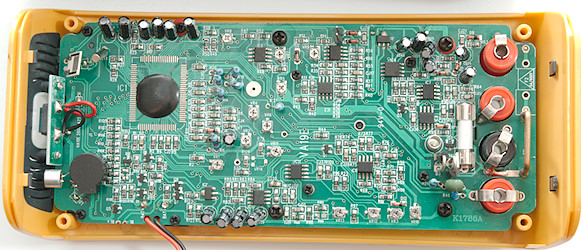
6 more screws for the front.
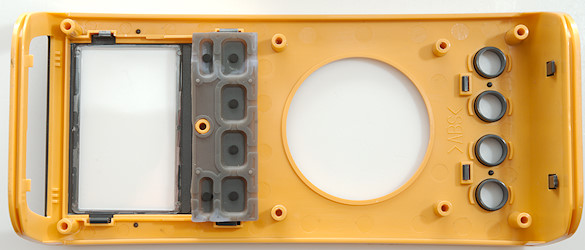
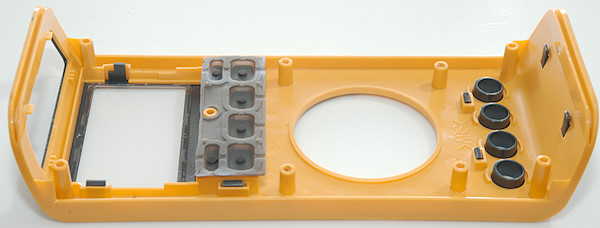
And four more screws to remove the circuit board.

Not much on this side, the green resistor is the 400mA shunt. The wire below the two red terminals is the missing 10A fuse.
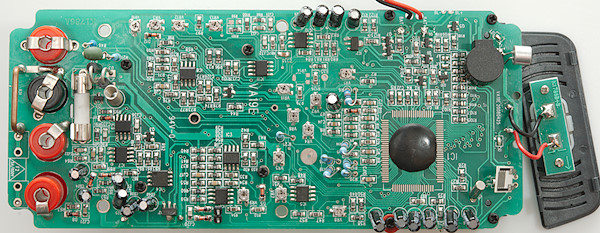
There is lot of chips on this side and also a lot of trimmers (I counted 12), I tried to identify some of the chips:
IC3: 27L2C – TLC27L2 Dual precision OpAmp
IC7, IC8, IC9, IC10, IC11: GZ525 (ST) – probably a dual OpAmp
IC5: 271C – (TI) TLC271C Programable OpAmp
IC6: LM358 (TI) – Dual OpAmp
IC2, IC12: 7530-1 – Voltage regulator
Generally there is not much protection, near the voltage input is a green PTC
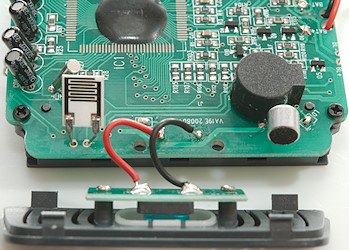
At the front/top is the sensors. A humidity sensor (White ceramic), a photo diode on its own circuit board and a microphone.

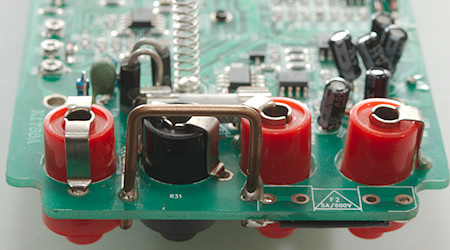

Conclusion
Without a fuse on the 10A range the meter can not live up to any CAT rating.
I have not done a fast check of the environment functions and they did not look very precise. The normal DMM functions works fine, but it is missing uA and have a fairly high burden voltage in the 400mA range.
For comparing light sources with the same type of bulb the light meter is fine, but it cannot compare a led to a incandescent correctly, with sound it can compare noise from the same source, but because its sensitivity do no match the ear, it cannot be used to evaluate noise levels.
Notes
How do I review a DMM
More DMM reviews
My website with reviews of many chargers and batteries (More than 1000): http://lygte-info.dk/